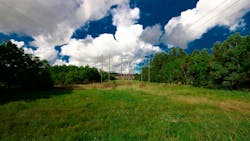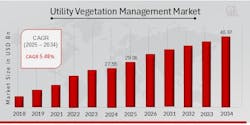Utility Vegetation Management Market to Reach US$46.97 Billion by 2034, Rising at 5.48% CAGR
The global utility vegetation management market is witnessing steady growth, driven by the need for power infrastructure resilience, growing frequency of weather-related outages, and regulatory mandates aimed at maintaining reliable electric service. With a projected CAGR of 5.48% during the forecast period 2025-2034, the market is expected to rise from US$29.06 billion in 2025 to US$46.97 billion by 2034, according to a recent report from Market Research Future. As demand for uninterrupted power delivery intensifies, utilities are adopting advanced vegetation management techniques to protect transmission and distribution assets from interference caused by overgrown trees and plant life.
Market Drivers
The primary driver of the utility vegetation management market is the increasing number of weather-related disruptions affecting power lines. With the rise in extreme weather events-such as wildfires, storms, and hurricanes-utilities face mounting pressure to proactively manage vegetation near electrical infrastructure. Trees contacting power lines are among the leading causes of outages and fire ignition, prompting governments and regulatory bodies to enforce stricter compliance standards.
Another critical driver is the aging infrastructure in developed economies, particularly in North America and Europe. Many power lines and grid assets were designed decades ago and are now susceptible to environmental damage, including interference from overgrown vegetation. To ensure safety and service continuity, utilities are upgrading monitoring and maintenance programs, often using geospatial and predictive analytics for more targeted operations.
Urban expansion and right-of-way encroachments are also influencing the market. As cities grow and suburban developments stretch closer to transmission corridors, maintaining adequate clearance and ensuring compliance with vegetation safety standards becomes essential to avoid legal liabilities and service interruptions.
Digital transformation and the integration of advanced technologies such as AI, LiDAR, satellite imaging, and drone-based surveys have streamlined vegetation risk assessment and maintenance planning. These innovations allow for precise, data-driven interventions, reducing operational costs and improving service reliability.
Key Market Trends
One of the most significant trends in the utility vegetation management market is the adoption of remote sensing and drone technology. Utility companies are leveraging drones equipped with high-resolution cameras and LiDAR to survey transmission corridors quickly and accurately. This trend not only enhances safety by reducing the need for manual inspections in hazardous areas but also shortens response times and improves vegetation risk modeling.
Another key trend is the shift from reactive to predictive maintenance. Rather than relying solely on periodic trimming cycles, utilities are increasingly using predictive analytics to prioritize vegetation management activities based on real-time risk assessments. Machine learning algorithms can evaluate historical outage data, weather forecasts, and vegetation growth rates to recommend timely interventions that prevent outages and reduce costs.
The integration of geographic information systems (GIS) is becoming mainstream in vegetation management planning. GIS platforms allow utilities to map asset locations, vegetation zones, and environmental risks in a unified system, enabling real-time decision-making and improving regulatory compliance.
Environmental and social governance (ESG) is also influencing vegetation management practices. Utilities are being held accountable for their ecological impact and are incorporating sustainable practices such as selective trimming, preserving biodiversity, and minimizing herbicide use while meeting safety standards.
Regional Analysis
North America holds the largest market share in the global utility vegetation management industry, driven by stringent regulatory oversight, aging grid infrastructure, and increasing wildfire risks-particularly in the United States and Canada. Regulatory mandates from agencies such as FERC and NERC have placed utilities under obligation to maintain strict vegetation clearance, which is fueling ongoing investment in vegetation control services and technologies.
Europe follows closely, with countries like Germany, the UK, and France modernizing their electrical infrastructure and adopting precision vegetation management tools to prevent service disruptions. The region's strong emphasis on sustainable energy practices and biodiversity conservation is also shaping vegetation control strategies.
Asia-Pacific is projected to be the fastest-growing region, supported by rapid urbanization, infrastructure expansion, and government investments in power grid reliability. Countries such as China, India, and Australia are facing increased grid loads and environmental challenges, including monsoons and bushfires, prompting utilities to adopt modern vegetation management systems.
Latin America and the Middle East & Africa regions are gradually expanding their market presence as well. In these regions, utility providers are partnering with technology vendors to integrate cost-effective vegetation surveillance and control measures that enhance power delivery while optimizing limited resources.
Challenges and Constraints
Despite promising growth, the utility vegetation management market faces several constraints. One of the most persistent challenges is the high operational cost of vegetation control programs, especially in remote or rugged terrains. Traditional trimming and maintenance activities are labor-intensive and require specialized equipment, leading to significant financial outlays.
Data accuracy and integration issues also hinder the implementation of advanced technologies. Many utilities still operate with legacy systems that are incompatible with modern GIS or AI platforms. Migrating to digital vegetation management tools requires investment in infrastructure, training, and cybersecurity measures, all of which can delay adoption.
Additionally, utilities must navigate complex environmental and community regulations. Trimming vegetation, particularly in protected ecological zones or near residential areas, often requires permits and public consultations, adding time and complexity to operational workflows.
Workforce shortages and a lack of skilled personnel also challenge the scalability of vegetation programs. As experienced utility arborists retire, the need for new, digitally trained workers is growing, requiring industry-wide investment in workforce development.
Opportunities
Despite these challenges, the utility vegetation management market presents significant opportunities for innovation and growth. The expanding adoption of AI and machine learning offers enormous potential for optimizing risk assessment and reducing unnecessary maintenance. Utilities can forecast vegetation-related threats with high accuracy and deploy crews only when and where needed, improving operational efficiency and reducing overhead.
The growing focus on climate resilience and disaster preparedness is creating new demand for comprehensive vegetation management strategies. Governments are allocating funds and grants for grid hardening projects that include vegetation control as a critical component, opening up opportunities for vendors and service providers.
There is also a rising opportunity in software-as-a-service (SaaS) vegetation platforms. These cloud-based solutions offer utilities of all sizes the ability to manage assets, monitor compliance, and deploy resources remotely, all while minimizing IT infrastructure costs.
Partnerships between utilities and environmental organizations are fostering the development of eco-conscious vegetation strategies. These collaborations allow companies to comply with regulations while enhancing community relationships and public trust.

